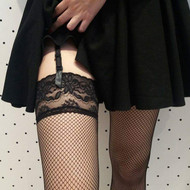6 Amazing facts about Stockings/Hosiery
Posted by Dream Hosiery on 5th Mar 2020

Stockings always were worn around the Northern Hemisphere. Now it is almost impossible to determine when the first pair of stockings was created.
In Tyrol Otzi, frozen in the Alps more than 5,000 years ago, knitted socks were found. In the bottom of the Egyptian tombs (1900 BC), an image of a woman wearing socks is preserved. An imprint of a stocking was discovered in the lava of Pompeii in 79 AD.
1) Baby stockings III-IV AD found in Egypt. These stockings already were made with a shape of shoes in mind - sandals with a strap after the thumb. Archaeologists managed to extract knitted children's socks from a fifth-century Coptic burial. Later, somewhere in the IX-XI centuries, some skilled knitters even began to put texts on socks. In the museums of Detroit and Badel, such examples of ancient Egyptian knitting from cotton threads with ancient Arabic text are stored.
2) The Middle Ages did not yet know the stocking as an independent element of clothing. Legs were wrapped in stockings made of cloth, canvas or thin leather. Each stocking was attached with laces to the belt, and later to the jacket. In the XIV - XV centuries, it became fashionable to wear a pair of stockings of different colors. In Italy, leather soles were sewn on them so not to wear shoes. For this reason, stockings in France were first called the `bottom of the pants`.
3) Spain is considered to be the homeland of knitted stockings. Here they were knitted by hand and decorated with embroidered color inserts. As if the first knitted silk stockings were worn by King Henry VII, and the first woolen count Pembroke. Such stockings were valued so highly that the English king Henry VIII (1491-1547) received them as a gift. His daughter, Queen Elizabeth I (1533-1603), became the happy owner of silk stockings. But during the years of her reign, the whole of England was already engaged in knitting stockings (though woolen, not silk).
4) Previously, stockings were cut out of some fabric, and sewn together in the shape of a leg. Most often they claim that the invention of knitting belongs to the Englishman William Rider in 1564. It is also true that in France King Henry II first showed up in silk knitted stockings at the wedding of his sister Margaret with Emanuel-Philibert of Savoy, in 1569.
5) Complicated case happened to the inventor of the hosiery knitting machine, a contemporary of Shakespeare, William Lee from Woolbridge in Nottinghamshire. The legend says: the master of philosophy, a Cambridge graduate, fell in love with a knitter girl and tried to lighten her and her fate by inventing a knitting machine that could do the job ten times faster than the most deft knitter.
Without wasting time and effort, the young theologian set to work, and already in 1589 one of his first machines came up to work. With that machine the knitting could be done with a thousand two hundred loops per minute instead of a hundred with ordinary hand knitting, but Lee couldn't get a patent because Her Majesty believed that one should not give knitting stockings to power for supplying many people.
Soon, Lee built a machine for knitting silk stockings, but neither Elizabeth nor her successor Jacob I showed interest in it. The desperate inventor had no choice but to accept the invitation from French king Henry IV and moved to France.
6) For a long time, knitting was considered exclusively as a male craft, both in Germany and in England;
But, as with any monopoly, frequent controversial issues and processes began to arise, as a result these rights were canceled in 1753. Since then, many improvements have been made in England to machine hosiery, and it is now believed that more than a fifth of all knitted stockings used worldwide are made in England. Notinghamshire, the birthplace of this craft, has still remained the center of hosiery knitting in the United Kingdom, at least for relatively cheap varieties, although the best English stockings are made in Belper.
Stay connected and wear quality stockings.
With love,
DH

